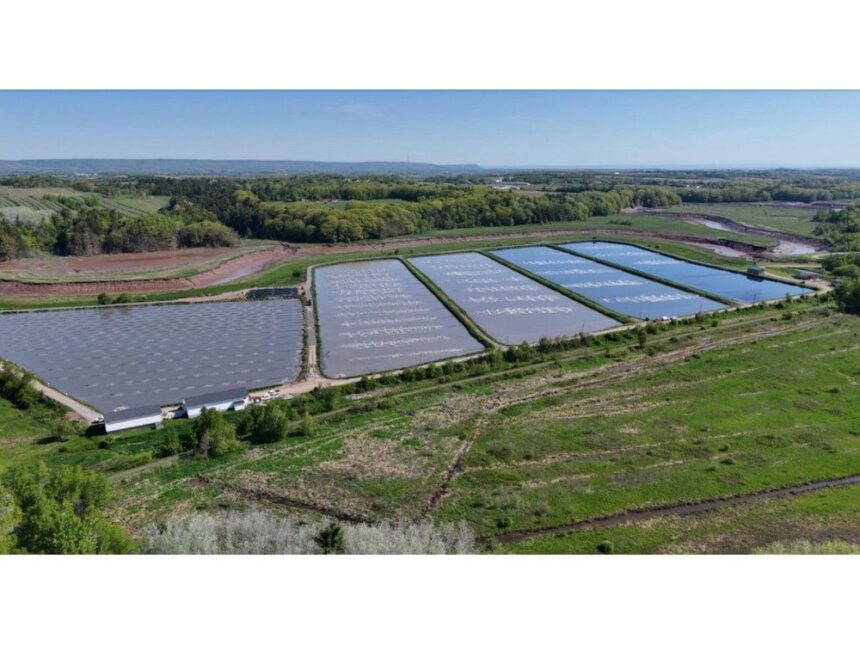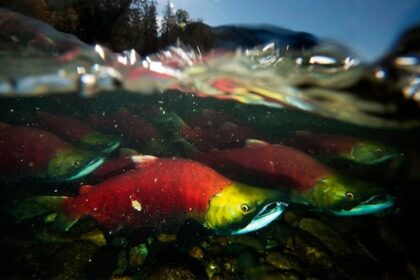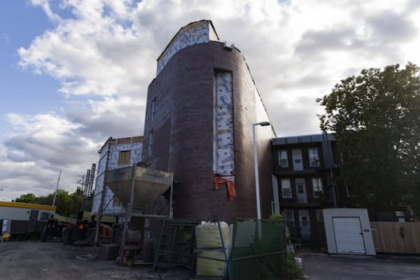County of Kings CAO says second treatment lagoon lacks dissolved oxygenPublished Jun 20, 20258 minute readThe regional sewage treatment plant in New Minas has five treatment lagoons. County of Kings chief administrative officer Scott Conrod said in a June 17 presentation that it appears the lagoon, second from left, is currently the main cause of a recurring odour problem. Photo by COUNTY OF KINGSArticle contentThe second of five treatment lagoons is apparently the current leading cause of a recurring foul odour emanating from the regional sewage treatment plant in New Minas.THIS CONTENT IS RESERVED FOR SUBSCRIBERS ONLY.Subscribe now to access this story and more:Unlimited access to the website and appExclusive access to premium content, newsletters and podcastsFull access to the e-Edition app, an electronic replica of the print edition that you can share, download and comment onEnjoy insights and behind-the-scenes analysis from our award-winning journalistsSupport local journalists and the next generation of journalistsSUBSCRIBE TO UNLOCK MORE ARTICLES.Subscribe or sign in to your account to continue your reading experience.Unlimited access to the website and appExclusive access to premium content, newsletters and podcastsFull access to the e-Edition app, an electronic replica of the print edition that you can share, download and comment onEnjoy insights and behind-the-scenes analysis from our award-winning journalistsSupport local journalists and the next generation of journalistsRegister to unlock more articles.Create an account or sign in to continue your reading experience.Access additional stories every monthShare your thoughts and join the conversation in our commenting communityGet email updates from your favourite authorsSign In or Create an AccountorArticle contentCounty of Kings chief administrative officer Scott Conrod and environmental services manager Martin Kehoe presented an update to councillors at the June 17 committee of the whole session.Article contentArticle contentArticle contentConrod said that a couple of years ago, aerators were replaced by diffusers based on engineering advice. These give a finer supply of air bubbles. However, the leading cause of odour is a lack of oxygen, and oxygen levels in lagoons one and two are not in balance with the strength or load of incoming waste.Article contentConrod said adjustments have been made in the third, fourth, and fifth lagoons. The level of dissolved oxygen in those lagoons is “quite healthy now” and they’re not generating any odour.Article content“We’re still having difficulty with lagoons one and two and, in particular, I’m advised earlier this morning that it’s really lagoon two that’s giving us some continued grief, we’re not seeing any dissolved oxygen,” Conrod said.Article contentArticle contentHe said staff are working on the problem every day and are trying different measures. They’re getting new engineering advice daily, trying to increase dissolved oxygen levels in lagoons one and two.Article contentArticle contentConrod said that after the plant was recommissioned following an extensive upgrade a couple of years ago, “we witnessed better operating numbers than we had seen in years.” Municipal officials knew it wouldn’t last forever but truly believed they had several years of improved performance ahead.Article contentThey had proactively ordered new blowers in advance of the latest odour upset this spring, not in reaction to it. When the new blowers were being installed, staff stepped in on their own initiative when a subcontractor wasn’t there to finish making the connections to the header and piping in the first blower building.Article contentThe output of the new blowers, which are feeding the problematic second lagoon, was adjusted on June 16, increasing their output by 48 per cent. Conrod said dissolved oxygen levels have increased in lagoons three, four, and five since existing blowers were “tuned” recently, increasing air output by 70 per cent. They continue to dose the lagoons with an oxygen-boosting compound.Article content County of Kings chief administrative officer Scott Conrod and Environmental Services manager Martin Kehoe present an update on the regional sewage treatment plant in New Minas to Kings County councillors, including updated financial information. Photo by COUNTY OF KINGS – YOUTUBE IMAGEArticle contentConrod said staff are acting on recommendations to adjust the orientation of mechanical mixers in the first lagoon, so sewage is being pushed out toward the air diffusers instead of being pushed back against the banks of the lagoon. This is being done to increase oxygenation as much as possible.Article contentHe said that in consultation with the regional technical subcommittee, it was decided that because they aren’t seeing the return of dissolved oxygen in the second lagoon, materials have been ordered to install an additional string of diffusers.Article contentAn engineered design is underway for the addition of seven or eight more diffuser strings in the first lagoon. Conrod said it sounds easy, but there is a lot of math behind it in terms of friction loss and output from the blowers, for example.Article contentA smaller screen mesh has been ordered for rotating drums that process material coming into the plant, which is intended to address the amount of solids entering the first lagoon.Article contentArticle content“There has been quite a bit of conjecture over the years of the size of those screen mesh,” Conrod said, pointing out the impact this would have on addressing the odour problem is uncertain.Article contentHe said crews worked the previous weekend to remove “floating mats” from the second lagoon using a vacuum truck. These were taken off-site. This may or may not have an impact on the odour problem, but Conrod said it’s a variable they can control.Article contentConrod reiterated that during 2021 and 2023, more than 11,000 metric tonnes of sludge or biosolids were removed from the treatment lagoons, not including the weight of material stored in five geotubes.Article contentThe municipality has been measuring the buildup of biosolids with sonar technology, and sludge removal from the problematic second lagoon is planned for the fall. Conrod said this work was already planned before the most recent odour upset.Article contentArticle contentHe said that while the first lagoon was taken offline for the installation of new diffusers, the second lagoon was used as the primary treatment lagoon. This saw a lot of material enter that otherwise would not, and it needs to be “touched up.”Article contentDealing with biosolids, costsArticle contentRegarding the Class B biosolids removed from the lagoons, Conrod said that under current environmental regulations, their experience has been that land application is permitted but could not be accommodated due to the volume. He said they would like to do more on-site disposal, but they don’t have enough area at wastewater plant locations for direct land application or topping through a licensed windrow operation.Article contentClass A and B biosolid materials have storage restrictions, some of which relate to drinking water supplies, so this may not be possible due to New Minas’ wellfield protection regulations. Conrod said the material can be used in second generation landfill operations as daily cover or for cell closure, but it can’t be stockpiled under current environmental regulations. They’ve had to transport the material to a facility in Miramichi, N.B.Article contentHe said other municipalities have had similar experiences, and the disposal issue will be revisited prior to the 2025 sludge removal project.Article content“Simply put, there needs to be a Nova Scotia solution,” Conrod said. “That’s going to take some time to get that in place.”Article contentConrod shared a table showing the cost of regional sewage treatment system upgrades between 2019-2020 and 2024-2025, totalling $12,522,958. He told councillors the total “will go up” because they’re still in the process of closing out the numbers as of March 31, 2025.Article contentThe total spent on sludge management during that timeframe is $4,649,240, including transportation and disposal costs.Article contentAnother $4,625,000 is budgeted to be spent on capital improvements in 2025-2026, including $1.6 million for sludge removal. Conrod said this was approved before the most recent odour upset.Article contentArticle content“Oftentimes, we get the question, ‘Is money the issue,’” Conrod said. “I don’t usually say something like this, but money’s not the driving issue here. There is money, money has already been approved.”Article contentHe said there is additional money being spent on engineering consulting and other expenses, but this cost can likely be covered within the approved $4.625-million capital spend.Article contentFor the long term, consulting engineering firm CBCL was hired in February to undertake a pre-design report on the entire system. The study is scheduled to be completed by spring 2026. Work has been delayed because the same consultant has been asked to advise the municipality on present-day odour and treatment issues.Article contentThe work will generate recommendations related to the treatment plant, including process upgrades such as pre-screening solutions, possible conversion to alternative treatment technologies, post-treatment clarification or filtration, sludge management solutions and overall treatment facility optimization. The study will encompass the type of incoming waste and projected growth and development in the service area.Article contentArticle contentConrod said the pre-design report generated by CBCL would be made available to the public when it’s completed.Article contentHe said municipal officials have been assembling a living document on the municipal website to address some frequently asked questions about ongoing problems at the regional sewage treatment plant.Article contentThe document is being updated based on the types of discussions they’re having with citizens, engineering advice, and the actual work that is being undertaken in an effort to keep the document as current as possible.Article contentHealth impacts, other questionsArticle contentCoun. Emily Lutz asked if there are any health impacts due to exposure to the sewage odour.Article contentConrod said he isn’t qualified to answer that question, but the message was delivered “loud and clear” at a recent New Minas Village Commission meeting, where they made a presentation, that this is something they should be looking at.Article contentHe said their workforce wears gas detection monitors when working at the plant, and these monitors have yet to go off.Article contentCoun. Bob Best asked what the advantage is of waiting until fall to remove sludge from the second lagoon when problems are being experienced now. Conrod said they typically wait until temperatures start to cool down to help minimize odour upset.Article content“Should we clean them all out and start from scratch again,” Best asked, pointing out he realizes this would be very expensive.Article contentConrod said they’re using sonar to determine how much sludge is in the lagoons, and right now the second lagoon is the top priority. However, he said his understanding is the buildup is not to the extent that removal must be done sooner than later, and it’s not to the extent that it was prior to the last desludging.Article contentEnvironmental services manager Martin Kehoe said the second lagoon currently has more than 4,000 cubic metres of sludge identified in the sonar survey.Article contentArticle contentKehoe said the third lagoon currently holds about 6,100 cubic metres, while the fourth and fifth lagoons are at about 2,800 cubic metres each. On the recommendation of their consultants, they are going to begin removing sludge from the other lagoons once the second lagoon has been cleaned out.Article contentConrod said they may have enough money already approved to do more sludge removal than what is planned for the second lagoon. However, they won’t know until the numbers are confirmed by contractors.Article contentCoun. Everett MacPherson asked how the municipality came to be the owner of the system and have so much responsibility over its operation when the County of Kings accounts for only 17.7 per cent of the volume entering the regional sewage treatment plant.Article contentConrod said it is a good question, and he wishes he had a good answer, but “institutional memory” is not great when it comes to the basic question of why the municipality owns the assets.Article contentArticle contentHe said there was a discussion of governance and ownership at a recent technical subcommittee meeting, but with attention currently focused on dealing with the odour problem, “it’s a subject that has to come back up.” This would include discussion of establishing a common regional sewage treatment system bylaw among partner municipalities with enforceable punitive measures for summary offences.Article contentArticle contentAbout the regional sewage systemArticle contentMore than 22,000 residents between Coldbrook and Greenwich, many commercial and industrial users, and institutions such as the Valley Regional Hospital use the regional sewage treatment system, which is at about 50 per cent capacity.The system is owned by the County of Kings and is operated as a partnership of the County of Kings, Town of Kentville, Village of New Minas, and PepsiCo.Regional sewage treatment system operating partners participate on the regional sewer committee.The lagoon-based, biological treatment plant retains wastewater for about 60 days from the time of inlet, through the five lagoons, to the point of effluent discharge.After cycling through the treatment process, treated wastewater passes over ultraviolet (UV) lights.Article content
Work continues to resolve New Minas, N.S., sewage stench, answer questions












